Archive for the ‘Wonderboy’ Category
The other day I pulled one of our breakfast standbys, Favorite Poems Old and New, off the shelf. As they do every single time I so much as glance in that book’s direction, the girls immediately began begging me to read “the funny poem.” They were referring to Thomas Hood’s undeniably amusing poem, “A Parental Ode to My Son, Aged Three Years and Five Months,” which has been a family favorite ever since (who else?) Alice pointed me toward it when Jane was a four-year-old.
I think I recall Liz posting this same poem on Poetry Friday last year, but we had such a funny time with it this week that I can’t resist sharing it again. Because, you see, though we have read this poem together at least a hundred times, this was our first time enjoying in the company of an actual boy aged three years and five months.
Jane’s the one who realized the coincidence. When I read the title, she gasped and shouted, “Hold on,” then did some rapid mental calculating. “YES!” she hollered. “That’s exactly how old Wonderboy will be NEXT WEEK!”
“Read it, read it!” the others chanted. Mind you, a proper recitation of this poem requires some effort. You need to intone the odd lines, which are the flowery ode the poet is writing about his son, in stentorian tones for maximum contrast to the even lines, which are the poet-father’s exasperated remarks to his wife and son as the boy interrupts Dad’s efforts to pen some fine phrases. The poem’s humor lies in the complete disconnect between the way the father describes his child and the way he actually feels.
Any mother who has ever tried to write a blog post about her beloved children while simulateously fielding interruptions from those children can certainly relate. Ahem.
I have often used this poem as a discussion-starter in writing workshops and conference talks. Its use of overblown imagery in the “ode” lines provides a good introduction to the use (and mis-use) of figurative language in poetry, not to mention authenticity. The father-poet contradicts his own metaphors line after line.
I remember Rose and Beanie guffawing along with Jane years before they were old enough to understand any of the jokes. But none of the howling renditions we’ve shared over the years compared to yesterday’s, with Wonderboy, who really does have the funniest Popeye squint sometimes, leaning against my rocking chair and grinning his new gap-toothed grin at his sisters’ uproarious laughter.
Anyway, here it is, for your enjoyment:
A PARENTAL ODE TO MY SON,
AGED THREE YEARS AND FIVE MONTHS
by Thomas Hood,
who was obviously a real dad
Thou happy, happy elf!
(But stop,—first let me kiss away that tear)—
Thou tiny image of myself!
(My love, he’s poking peas into his ear!)
Thou merry, laughing sprite!
With spirits feather-light,
Untouch’d by sorrow, and unsoil’d by sin—
(Good heav’ns! the child is swallowing a pin!)
Thou little tricksy Puck!
With antic toys so funnily bestuck,
Light as the singing bird that wings the air—
(The door! the door! he’ll tumble down the stair!)
Thou darling of thy sire!
(Why, Jane, he’ll set his pinafore a-fire!)
Thou imp of mirth and joy!
In Love’s dear chain so strong and bright a link,
Thou idol of thy parents—(Drat the boy!
There goes my ink!)
Thou cherub—but of earth;
Fit playfellow for Fays, by moonlight pale,
In harmless sport and mirth,
(That dog will bite him if he pulls its tail!)
Thou human humming-bee, extracting honey
From ev’ry blossom in the world that blows,
Singing in Youth’s Elysium ever sunny,
(Another tumble!—that’s his precious nose!)
Thy father’s pride and hope!
(He’ll break the mirror with that skipping-rope!)
With pure heart newly stamp’d from Nature’s mint—
(Where did he learn that squint?)
Thou young domestic dove!
(He’ll have that jug off, with another shove!)
Dear nurseling of the hymeneal nest!
(Are those torn clothes his best?)
Little epitome of man!
(He’ll climb upon the table, that’s his plan!)
Touch’d with the beauteous tints of dawning life—
(He’s got a knife!)
Thou enviable being!
No storms, no clouds, in thy blue sky foreseeing,
Play on, play on,
My elfin John!
Toss the light ball—bestride the stick—
(I knew so many cakes would make him sick!)
With fancies, buoyant as the thistle-down,
Prompting the face grotesque, and antic brisk,
With many a lamb-like frisk,
(He’s got the scissors, snipping at your gown!)
Thou pretty opening rose!
(Go to your mother, child, and wipe your nose!)
Balmy and breathing music like the South,
(He really brings my heart into my mouth!)
Fresh as the morn, and brilliant as its star,—
(I wish that window had an iron bar!)
Bold as the hawk, yet gentle as the dove,—
(I’ll tell you what, my love,
I cannot write, unless he’s sent above!)
This week’s Poetry Friday roundup can be found at A Wrung Sponge.
Monday morning, early. Wonderboy and I are off to speech therapy in a few minutes. His sessions have been going wonderfully well, and he is now regularly saying B and P sounds. This is huge progress; two months ago his only consonants were M, hard G, K, N, and an occasional H (as in "Huh moni!"—that’s "Good morning" to you conventionally annunciating types).
He loves Miss Tammie, the speech therapist, and our fun half-hours in her room, playing games, singing (okay, listening to Miss Tammie sing), putting the buh buh baby and the puh puh popcorn on the buh buh bus, and the puh puh puppy goes in the buh buh box.
His astonishing and rapid progress is due in large part, I believe, to Tammie’s use of something called "Visual Phonics." This language development program is actually new to Tammie, and we are more or less learning it together. The concept is truly brilliant. In Visual Phonics, a hand sign is assigned to every single sound. It’s like taking the sign language alphabet (with which Wonderboy is already quite familiar, though he does not sign it himself yet—when he was two, his favorite way to fall asleep was to watch my hand while I signed and sang the ABCs) one step further.
For example, there a sign for the B sound (buh). You use the ASL sign for B, a flat hand, fingers together and pointing up, thumb folded over the palm, and you hold that handshape up by your mouth, moving the B away from your lips as you say "Buh."
Not all the Visual Phonics signs are based on the ASL alphabet; the P has your fingers sort of exploding away from your lips. Really, it hardly matters WHAT the signs are; the brilliant innovation was in attaching signs to these small units of sound. There are signs for every speech sound, including consonant blends and all the vowel sounds, including diphthongs.
Wonderboy GETS sign language; he knows how to connect a sign to a spoken word to a thing or idea. He clicked with the concept of buh and puh immediately, just as soon as we turned the sounds into Real Things for him by giving them signs.
I missed a chance to go to a Visual Phonics training session last month, but I’ll share more about the program as I learn about it. It is primarily intended to help kids struggling with reading, but Gallaudet and other institutions have recognized its immense value in both reading and speech instruction for deaf/hard-of-hearing kids. I imagine Visual Phonics is going to be a big part of our lives these next few years, first in helping my boy learn to speak English, and later in helping him learn to read.
Buh buh brilliant. Also, buh buh bye—I’ve got to run or we’ll be late!
April 8, 2007 @ 7:16 pm | Filed under:
Wonderboy Since you asked…here’s that new toothless grin. Still cute, but I miss the old one!

And as long as I’m uploading…

I know, buddy. I can’t believe her birthday is a week away either.

Did you know that ears are one of the few body parts that never stop growing? I think noses might be the other. Besides hair and fingernails, obviously.
When you wear behind-the-ear hearing aids, the hearing aids last for years, but the ear molds—the little custom-made silicone or acrylic doohickeys that fits into your ear—need replacing every so often. As your ear grows, the ear mold ceases to fit, and first you get a feedback problem, and then eventually the mold just won’t stay in the ear at all.
So you go to the audiologist’s office, and she makes new impressions of your ears with a quick-hardening goo. You ship the impressions off to a lab, and in a couple of weeks you’ll have your brand new ear molds.
If you are three years old, you may find this process somewhat entertaining, if mildly uncomfortable. If you are six years old and the uncomfortable part is happening to your brother, not to you, you will consider it a ripping good time. Beanie pronounced it “huge fun.”
I get a large number of hits every day from hearing-aid-related searches, including variations of “toddler ear molds,” so I thought it might be helpful if I posted a walk-through of the process. Besides, pictures are always fun.
First the audiologist checks your ears, making sure there isn’t too much wax in there—that might mess up the shape of the impression. Then she carefully inserts a little foam stopper to make sure none of the impression goo goes too far up the ear canal.
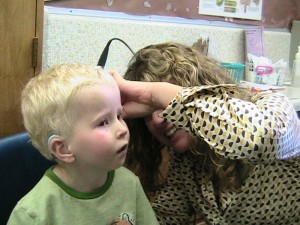
Then she pops the two kinds of goo out of their little bubble wrappers, and she mixes them together into a pliable substance that can be squeezed out of a syringe but will harden within a few minutes. Beanie, supervising, thought this mixing process looked pretty nifty and is now wondering how to work “become an audiologist” into her plan to be a scuba-diver with ten children.
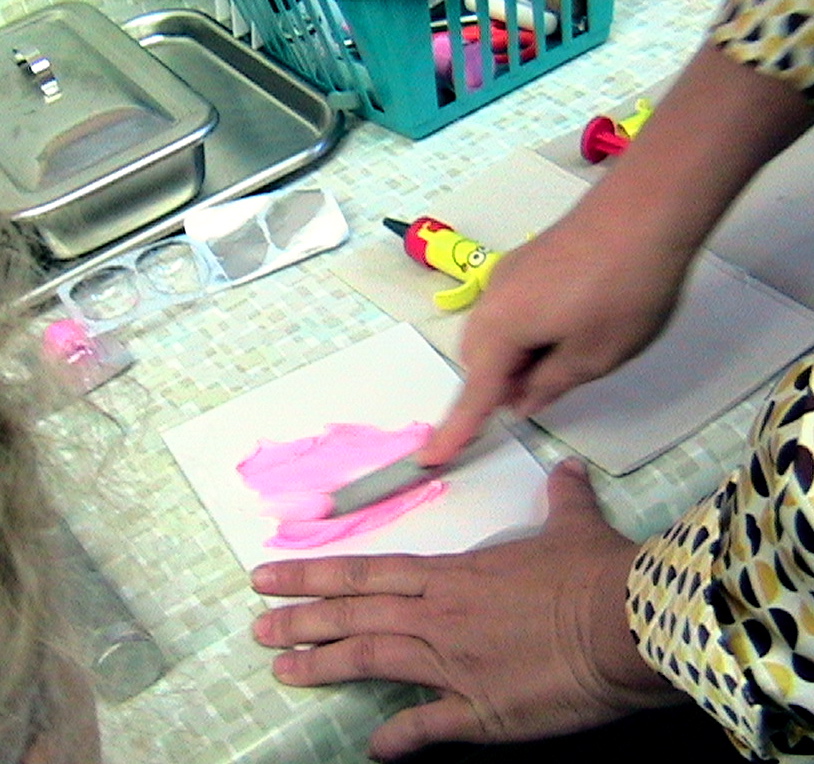
The audiologist scoops the goo into the syringe and carefully squeezes it into the ear, sort of like making an icing rose on a birthday cake. Now you have to sit and wait. You can’t poke at the goo, much as you might wish to. Nor can you pull on the string that is connected to the little foam stopper inside your ear canal. Patience, grasshopper.

Meanwhile, the audiologist squirts the leftover goo out of the syringe. This, I am told, is THE BEST PART.
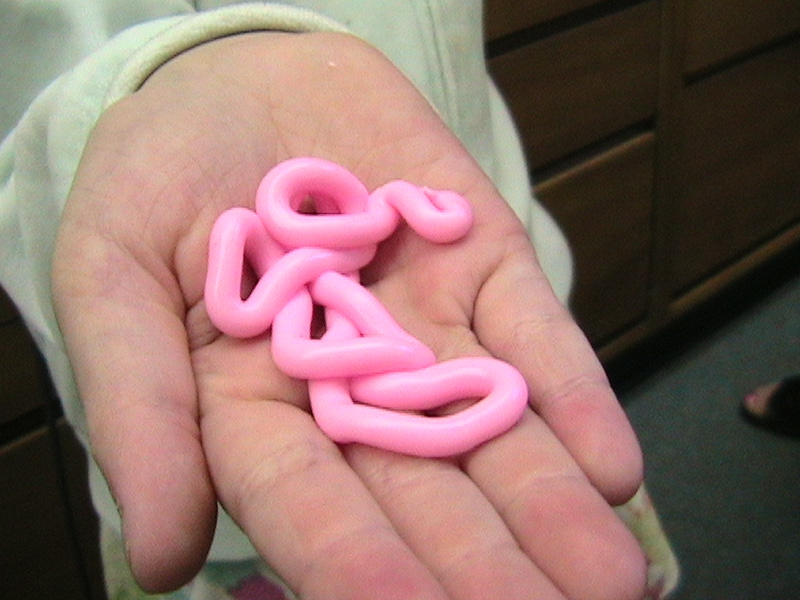
Let’s do the other ear while we’re waiting. It’s okay to drool.
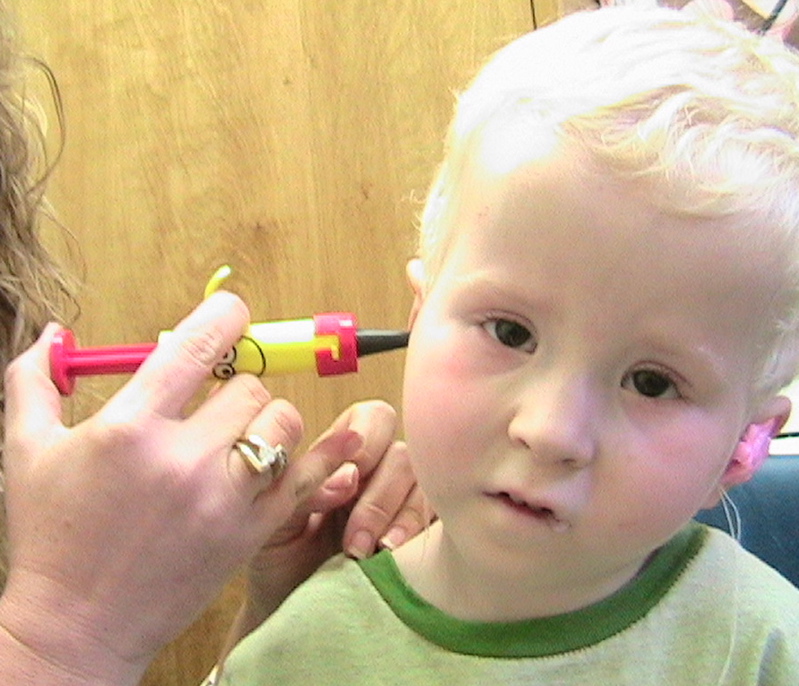
Finished! Time to pull out the impression. No need to be suspicious; it won’t bite.

The impressions go into a box and are dispatched to the Lab, that mysterious place where ear molds are born.
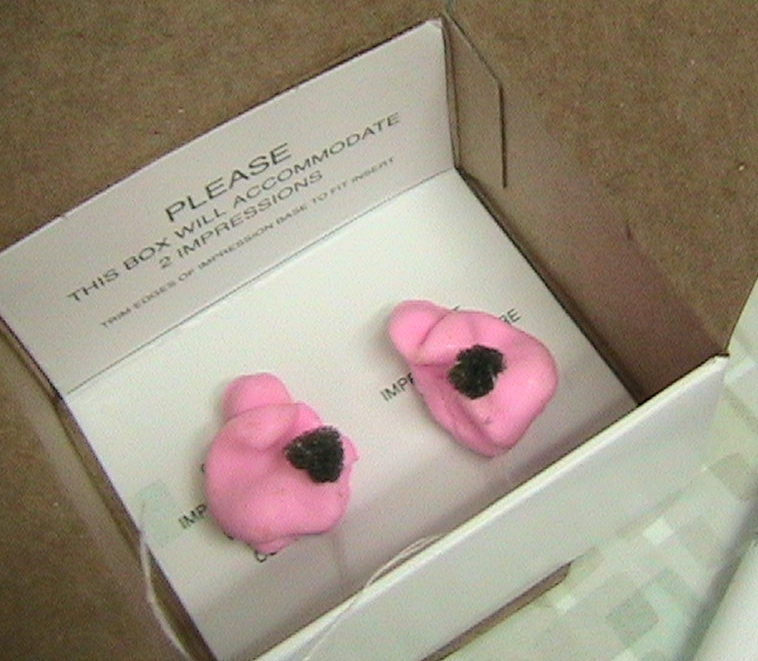
Now comes the fun part! (The other fun part, says Beanie.) What color ear molds do you want? The sky’s the limit. No, Bean, your brother isn’t getting the sparkles.
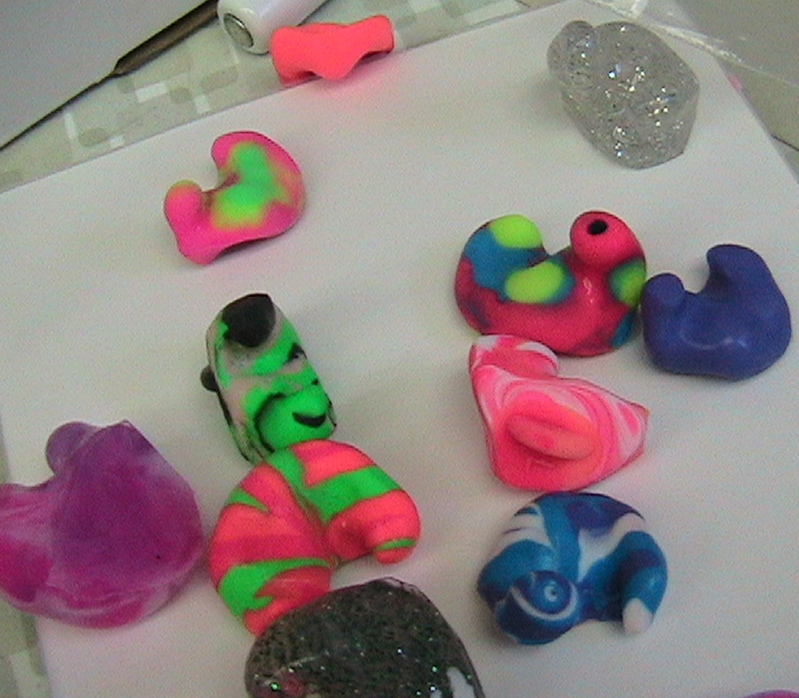
What color did he get? You’ll have to wait two weeks to find out.
February 13, 2007 @ 5:11 pm | Filed under:
Wonderboy Wonderboy comes to me and delivers an incomprehensible message in whisper-sounds. I’m pretty sure he can’t even hear a whisper, but he can feel that it’s a different way of talking. Sometimes we are loud, "MOMMEEEE! WHERE GAY-GEE GO?" (The baby is on the move now, and Wonderboy finds her scoot-crawling mobility a bit stressful. Precious objects such as telephones and babies are supposed to stay where you put them. Aren’t they? Aren’t they? Where did she go? Doggone it, she’s halfway down the hall again, and I’m pretty sure she took the phone with her.)
Yes, sometimes we are loud, and sometimes we are hushed and whispery. He comes to me with his tight little grin and his proud whisper, and he pours forth a string of sotto voce gibberish, like my amateur actor friends and I used to do during party scenes in high-school plays.
His secret message thus transmitted, he giggles expectantly, eyes dancing. This is my cue: I whisper back, delivering my own incomprehensible message to ears that can’t detect these sounds even with technological assistance.
Suddenly he is all business, and he trots off down the hall to find Jane. That’s the game, see; he is carrying our messages from one end of the house to the other. I have no idea what she is saying on her end. I keep forgetting to ask her. It doesn’t really matter. We both know the substance of the message is joy.
First things first: I am happy to report that Friday’s adventure in ick wasn’t the first wave of something worse; Wonderboy stayed healthy over the weekend. Must have been carsickness (again).
But I promised to tell you how the IEP meeting went. It was a very good meeting and I got exactly the outcome I was looking for: Wonderboy will receive speech therapy and audiological services (ear molds, hearing tests) from our local school district.
There were six people at the meeting, plus me (and the boy and the baby). Audiologist, district school psychologist, two speech pathologists, itinerant deaf/HH teacher, deaf/HH preschool classroom teacher. That’s six, right? A goodish crowd. All very nice, all respectful and eager to meet us where we are.
After introductions, we discussed the various options open to my boy (preschool, private speech therapy, etc.). We talked about the results of his speech evaluation and his history. The deaf/HH preschool teacher described her program, which is a four-hour/five-day preschool in which three other students are currently enrolled. It sounds like quite a nice little program, but I don’t think it best fits the needs and situation of Wonderboy and the rest of our family, so I declined that option, choosing private speech therapy sessions and audiology services instead.
Then we looked at the "goals" that had been drawn up by the speech therapist, itinerant deaf/HH teacher, and audiologist. The way it works is you must spell out, on special forms, the goals you’re aiming for and the specific services that apply to each. For example, one goal for Wonderboy is to be able to make several additional consonant sounds in a year’s time. ("Child will correctly produce consonant-vowel-consonant words containing the phonemes b, p, m, t, d, with amplification [hearing aids], with 90% accuracy.") (That doesn’t guarantee he definitely WILL meet that goal by this time next year, but that’s what we’ll be aiming for.)
I was in complete agreement with the speech therapist’s goals and recommendations. I approved those pages and they made it into the final IEP.
However, I did not agree with the necessity of the itinerant teacher’s goals/recommendations. Her goal had to do with language development—not sounds, but using words and sentences—and I do not see a need for outside help in that area. (To put it another way: we can homeschool him in that just fine.) The teacher, who is a very nice and pleasant person, described a curriculum she would like to use—both directly with Wonderboy and "training" me to use it myself. I had to suppress a smile. The curriculum is designed to get a child talking about all the different parts of his day, using conversation about household objects and activities to develop facility with sentences and individual parts of speech.
I think we’ve got that covered.
So we scrapped that goal and its accompanying recommendation for services. This was not a big deal; there was no tension involved. As the parent, the final say on goals and services is up to me. But it was also up to me to decline this section of the proposed IEP.
I mention that here because I think it’s an important part of understanding the IEP process. The school district can make recommendations, but the parent must approve every syllable of the documentation. If you’re not happy with what’s in the IEP, don’t sign it until you are!
Which leads me to a very interesting and important thing I learned at the end of the meeting. I need to look into whether this applies to California only or the entire nation. As my pen was poised to sign the final paperwork, the psychologist notified me (as she is legally bound to do) that once the parent signs the IEP, the child is officially "in the system," and the parent can’t just decide later to pull him out of services without a big to-do. From that point on, the appropriate district personnel (in this case, speech therapist) must agree that the child no longer needs these services in order to cancel them.
This is a significant point. Apparently, it is a recent change to the law (again, I’m not sure whether we’re talking state or federal law—I’ll get back to you on that) during the past year.
Naturally, this caught my interest. I don’t like to be boxed into anything! Now, this news did not affect my course of action, because Scott and I had already made the decision to access these services through the school district instead of seeking them privately. We weighed the pros and cons before I ever picked up the phone to call the district.
But I was curious about how exactly this provision works. I asked what would happen if a parent wanted to pull her kid out of services, say, a month or two down the road. One of the teachers explained that if the speech therapist (or physical therapist, OT, etc) did not agree that the child’s special needs no longer existed, the case would have to go to mediation. If an agreement could not be reached—which I assume means "if the parent still wants out"—then the school district would initiate a due process hearing.
Got that, homeschoolers? If you decide to tap into the public schools’ special-needs services (which is your right), be sure you’re completely comfortable with the goals and services spelled out on the IEP before you sign it. Because once you do, you’re committed. Or rather, your child is. In California, at least.
So did I sign, you’re wondering. Yes. I do want to access the speech therapy and audiology services (ear molds, hearing tests) to which my son is entitled. After all, my tax dollars are helping to pay for these services. But this new law makes it all the more important to do your homework and to read the paperwork with an eagle eye. Make sure the IEP says exactly what you want, and not a syllable more, before you give it your John Hancock.
Related posts on accessing public services for special needs:
Beginning the Process
The Speech Evaluation
Getting an IEP
Last month I posted about beginning the process of setting Wonderboy up with speech therapy services through our local public schools. These things take time (especially during the holidays), and we are just now moving to the next step. Today will be the "goals" meeting with various district personnel to determine what will go in Wonderboy’s IEP, or Individualized Education Plan.
This important document will spell out what services Wonderboy will be getting from the district and what our goals are for his progress in the next six to twelve months. If he were enrolled in a public school, the IEP would also define what special arrangements would be necessary to help him in a classroom: accomodations such as an aide, an FM system, seating near the teacher, and so forth. (I’m giving broad examples here, not necessarily things that would apply to a three-year-old.)
In the home, meeting Wonderboy’s specific needs is much easier and more intuitive than would be the case in a preschool setting, so his IEP will serve chiefly to get him speech therapy. We have a couple of options for this, and part of my job as his "case manager" has been to educate myself about the possibilities. Our district does have a dedicated deaf/hard-of-hearing preschool classroom, and I have been strongly encouraged by district personnel to consider placing him in this class. I don’t at all mind their making a pitch for the preschool: it’s part of their job.
Neither do I have any qualms about politely declining the offer. Deciding what’s best for him is part of MY job.
Here are the steps that led up to today’s meeting:
• Knowing Wonderboy qualified for speech therapy, I called the district special education office and requested an evaluation. (Even if you are only wondering whether your child qualifies for services, you can call and request an eval. The purpose of the eval is to assess whether there is indeed a qualifying need. For children over three, call the local school district’s special ed office. For children under three, call the Early Intervention office. Google your town’s name and "early intervention" and you’ll probably find the number easily.)
• The special ed office asked me to fax over his IFSP (Individualized Family Service Plan). This is the equivalent of the IEP for three-and-unders. If we had not had an IFSP—that is, if I were seeking services for the first time—the special ed office might have asked to meet with us before setting up the eval, but not necessarily. The eval itself is what determines the child’s need for services. Certain medical information can be helpful, such as Wonderboy’s latest audiologist report.
• Special ed passed our name and number to the district speech pathologist (since I was asking for speech therapy). She called and set up the evaluation I wrote about in December. If I had wanted, a physical therapist could also have been present. (I opted to postpone his PT eval for a few months.)
• Also present at the evaluation was the district’s school psychologist. This is standard practice.
• The evaluation determined what we all already knew would be the case: Wonderboy does qualify for speech therapy through the district.
• Today’s IEP meeting was scheduled. This took some coordinating, as there is a rather large team of folks involved. This is why I think it’s important for parents to do their homework—especially homeschooling parents, but really it applies to all of us. It can be intimidating to walk into a roomful of school-system professionals. They are there to help, and as parent, you are the person in charge; but it can be hard for parents to remember that.
The "team" of people at Wonderboy’s meeting will be: speech pathologist, school psychologist, traveling deaf/HH teacher, dedicated deaf/HH classroom teacher, and district audiologist (yay!!). I think that’s it. And me, of course—on this team, I’m the coach!
• After the IEP meeting was scheduled, I got calls from most of the folks on this team. I had short preliminary meetings with the traveling deaf/HOH teacher and the school psychologist.
• Which brings us up to today. I’ll let you know how it goes.
Yesterday’s speech evaluation went very well. Wonderboy was obligingly talkative, so the speech/language pathologist (we’ll call her the SLP) was able to get a good idea of the range of sounds he can make. She was delighted, really excited, about the extent of his expressive and receptive language—his sentences seemed to thrill her as much as they do me. Of course, she could not understand much of what he says; his intelligibility to strangers is maybe 80%. But by the end of the session, she was catching a lot more of his words.
I had all the girls with me, of course, and they set up camp with their books and drawing materials at a table in the same room. They proved most useful in keeping the boy chatting; every time the SLP tried to get him talking about an object, he picked it up and trotted around to show his sisters, addressing them each by name.
"I can see you’re a big help with your brother’s therapy," said the SLP, which is absolutely correct. As we were leaving, she actually thanked the girls on Wonderboy’s behalf. It was a great moment. You always wonder what public school employees are going to think about your homeschooling brood, and it’s nice to leave feeling like you made a good impression. I really think she grasped the tremendous impact on Wonderboy’s progress (in both speech and motor skills) made by the constant interaction with his sisters.
All four of them! He considers the baby his special charge; he is always looking out for her welfare, bringing her toys, putting a pillow behind her when she is sitting on the floor. At the evaluation, some of his clearest words were about Rilla and the stroller.
We talked about the scheduling challenges, and as Peggy suggested in yesterday’s comments, the SLP is eager to accomodate our needs. There’s one 8 a.m. small-group session that currently has only two children in it; since my girls can come and hang out on the other side of the partitioned room, we should be able to make it work without too much disruption to our schedule (such as it is).
Next step: the Goals meeting. This is where the SLP and I will sit down with the district audiologist and the district psychologist to draw up the language for Wonderboy’s IEP. It’s scheduled for January, after the school break. Until then, we’ll just keep on doing what we’re doing, which seems to be working!
Today my ClubMom topics, homeschooling and special-needs kids, come together. I’m taking Wonderboy to our local public school—yes! I said public school!—for a meeting and evaluation with the special education office, a speech therapist, and the district audiologist. Even though we plan to home-educate this child like all our others, we can and will avail ourselves of the special services made available to all children according to federal law.
From birth to age three, qualifying children can receive services such as speech therapy, physical therapy, and occupational therapy through Early Intervention programs. Wonderboy received all of the above, in our home, beginning at about four months of age. (For PT & OT, that is. When his hearing loss was diagnosed months later, we added speech & hearing therapies.) The first step in the Early Intervention process is an evaluation that leads to the writing of a big ole document called an IFSP—an Individualized Family Service Plan.
At age three, children age out of Early Intervention and from that point on, the special services they qualify for come through the local public school district. The IFSP gives way to a new document, the IEP, or Individualized Education Plan. The IEP spells out what services the child requires and how the district is to go about answering the need. The whole IEP process can be tricky to navigate, or so I’ve picked up from several friends (public-schoolers, not homeschoolers) whose older children were diagnosed with learning disabilities or autism spectrum disorders. Those parents had to be sharp-witted advocates for their children to make sure that all their classroom needs were being met.
For us, it’s a bit simpler. Wonderboy "graduated" from PT before we left Virginia (amazing, amazing! miracle boy!), but he will almost certainly continue to need some speech therapy during the next several years. His verbal language skills are growing by leaps and bounds—really, it’s so exciting; he’s using long sentences now, like when I hollered "Ladies! Dinner’s ready in five minutes!" and he BOOKED down the hall shouting, "GIRLS! Time to eat! Dinner!" Excellent progress. But of course since he still lacks most consonants, it sounded more like "GUH! I oo ee! Ginnah!"
I want to make sure he has every advantage. I know his verbal skills will continue to improve naturally as he gets older. But he may need extra help to master certain sounds. And so after we got settled in here, I called the district spec ed office to see what kind of speech program they have. After a lot of faxing (his IFSP and audiology reports) and phone calls—just the normal process!—we set up an evaluation with the aforementioned folks.
Today we’ll be meeting to determine what goes into his IEP. I’m going to blog the process, because I haven’t found too much else out there about homeschoolers and IEPs. I might hold off on attending the speech therapy sessions until next fall, depending on how today’s eval goes. At Wonderboy’s age (he’ll be three this week!), speech therapy takes place in small parent-child sessions at the school up the road. That sounds great—but I can already see that timing will be tricky. I don’t know that I want to chop up a morning once a week with a jaunt to speech therapy. That’ll monkey with my older kids’ schedule.
But we can figure out the logistics later. Right now, step one: the speech evaluation.











